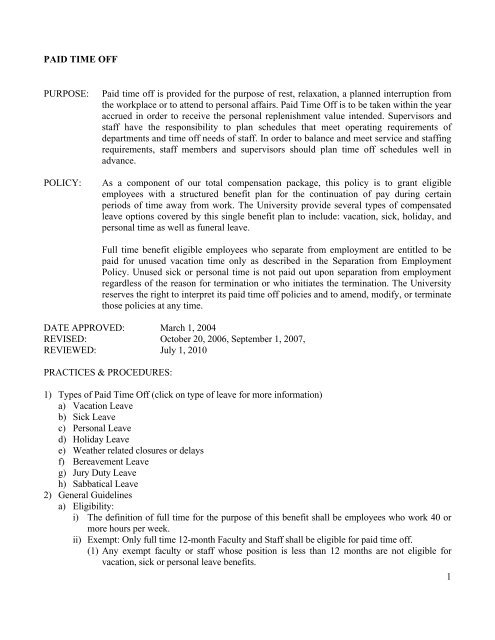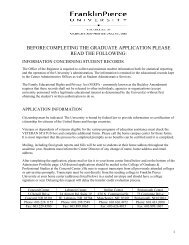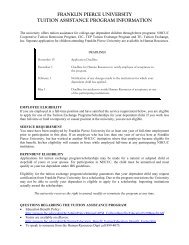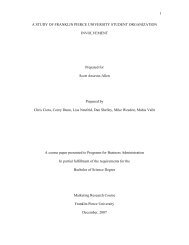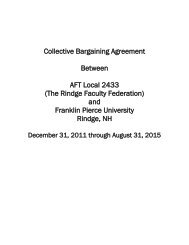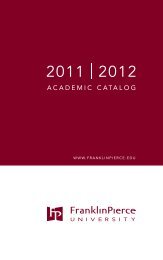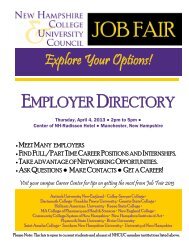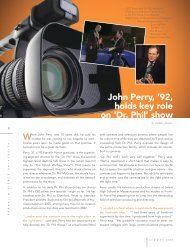Paid Time Off Policy
Paid Time Off Policy
Paid Time Off Policy
- No tags were found...
You also want an ePaper? Increase the reach of your titles
YUMPU automatically turns print PDFs into web optimized ePapers that Google loves.
PAID TIME OFFPURPOSE:POLICY:<strong>Paid</strong> time off is provided for the purpose of rest, relaxation, a planned interruption fromthe workplace or to attend to personal affairs. <strong>Paid</strong> <strong>Time</strong> <strong>Off</strong> is to be taken within the yearaccrued in order to receive the personal replenishment value intended. Supervisors andstaff have the responsibility to plan schedules that meet operating requirements ofdepartments and time off needs of staff. In order to balance and meet service and staffingrequirements, staff members and supervisors should plan time off schedules well inadvance.As a component of our total compensation package, this policy is to grant eligibleemployees with a structured benefit plan for the continuation of pay during certainperiods of time away from work. The University provide several types of compensatedleave options covered by this single benefit plan to include: vacation, sick, holiday, andpersonal time as well as funeral leave.Full time benefit eligible employees who separate from employment are entitled to bepaid for unused vacation time only as described in the Separation from Employment<strong>Policy</strong>. Unused sick or personal time is not paid out upon separation from employmentregardless of the reason for termination or who initiates the termination. The Universityreserves the right to interpret its paid time off policies and to amend, modify, or terminatethose policies at any time.DATE APPROVED: March 1, 2004REVISED: October 20, 2006, September 1, 2007,REVIEWED: July 1, 2010PRACTICES & PROCEDURES:1) Types of <strong>Paid</strong> <strong>Time</strong> <strong>Off</strong> (click on type of leave for more information)a) Vacation Leaveb) Sick Leavec) Personal Leaved) Holiday Leavee) Weather related closures or delaysf) Bereavement Leaveg) Jury Duty Leaveh) Sabbatical Leave2) General Guidelinesa) Eligibility:i) The definition of full time for the purpose of this benefit shall be employees who work 40 ormore hours per week.ii) Exempt: Only full time 12-month Faculty and Staff shall be eligible for paid time off.(1) Any exempt faculty or staff whose position is less than 12 months are not eligible forvacation, sick or personal leave benefits.1
iii) Non-Exempt:(1) All full time non-exempt staff shall be eligible for paid time off.(a) Full time non-exempt staff whose positions are nine (9) or ten (10) months in durationwill accrue paid time off hours on a prorated basis.b) Accrual Period:i) The accrual or accumulation of paid time off begins on the first day of the month followingthirty (30) calendar days of employment. This date subsequently becomes the employee’sbenefit accrual month.(a) All vacation, sick and personal time shall be accrued based on the number of months peryear they work.(b) All paid time off is awarded on the first day of the month.ii) All Staff members hired prior to April 30, 1984 will continue on a benefit accrual year thatcommences on May 1 of each year.c) Use of paid time off.i) All employees are required to request in advance and receive approval from their supervisorprior to the use of any vacation time.ii) When possible employees shall notify their supervisor in advance of taking any sick orpersonal time off, unless an emergency prevents them from doing so.(1) If the sick or personal leave is for an extended absence (three or more days) the employeemust also contact the Benefits Specialist in Human Resources to coordinate FamilyMedical Leave in accordance with the Federal Department of Labor regulations and theUniversity’s policy on FMLA.d) Supervisors are encouraged to coordinate paid time off schedules with their staff so that service tostudents and other departments will not be interrupted.e) Once time off is approved and has been submitted to your supervisor through the time andattendance program, it cannot be switched to another type of paid time off.f) Separation of Employment – payment of any accrued paid time off.i) Vacation Leave. Accrued but unused vacation may only be paid out to the separating employeeif he/she has given and worked through their resignation notice (2-weeks for non-exempt, 4weeks for exempt; or 3 months for executive) in accordance with the Separation fromEmployment <strong>Policy</strong>.ii) Once the employee resigns their position and begins their working notice, no paid time off maybe used.iii) No other paid time off benefit is paid out upon separation from employment regardless of thereason for termination or who initiates the termination.3) Vacation Benefit.a) Accrual Amounts.i) Exempt Staff(1) Staff members in twelve-month positions will accrue vacation time at the rate of two (2)days per month for ten (10) months up to a maximum of twenty (20) days per benefitaccrual year.ii) Non-Exempt Staff(1) Staff members will accrue, or accumulate vacation time at varying amounts of hours on amonthly basis as shown below:0 - 4 Years of Service - 8 Hours Monthly or 80 hours per year5 - 9 Years of Service - 12 Hours Monthly or 120 hours per year2
10 + Years of Service - 16 Hours Monthly or 160 hours per yeariii) Maximum Accrual(1) Staff members may accrue up to a maximum of 160 hours (Non-exempt) or twenty (20)days (Exempt).(2) In extreme cases when Staff members are unable to take vacation time throughout the yeardue to work demands, the limit on accrual may be exceeded. This requires the priorapproval of the Director of Human Resources at the recommendation of the Division VicePresident.iv) Should the employee terminate before his/her vacation balance returns to 20 days or less, theUniversity shall only be eligible for a pay-out of 20 days’ vacation.b) Recording Vacation <strong>Time</strong>.i) Non Exempt(1) Non-exempt employees are required to record all vacation hours daily as used.(2) Vacation time may be taken on one quarter (¼) hour increments.(3) Employees, who are on vacation when time sheets are due, must complete their timesheets and submit them electronically to their supervisor prior to their departure.ii) Exempt(1) Exempt employees are required to record all vacation days used weekly and provide totheir supervisor by June 15 th each year an accounting of all time used for the previous 12-months.(2) Vacation time must be used in full day increments.4) Sick Leavea) Approved Use of Sick/Health Days:i) Proper use of paid sick/health time would include time taken for illnesses or injuries that createthe following circumstances:(1) Required confinement that would prevent the performance of usual and customary workrelated functions.(2) Contagious diseases that would jeopardize the health of co-workers.(3) The medically required use of prescribed drugs that impair motor and/or thinking ability.(4) Appointment(s) with health care providers, including laboratory testing, medicalprocedures, and examinations.(5) Sick/health time may also be used for preventative health care. However, since medicalappointments are usually planned in advance, the employee must notify the supervisor atthe earliest time possible, but must provide a minimum of five (5) working days’ noticeprior to the absence. Preventative health care may include time-off for the followingplanned activities:(a) Annual physical examination or checkup with a physician.(b) Medical examinations by specialists when referred by the primary-care physician.(c) Care for any chronic condition that requires visitations to clinics, laboratories, andhospital outpatient visits. This would include immunizations, chemical and radiationtreatments as well as physical and psychiatric therapy.(6) An illness or injury which results in an absence of three (3) or more consecutive work daysshall require the employee to return to work with a written note from their physician.(a) In addition, the employee will be required to contact the Benefits Specialist in HumanResources to complete FMLA paperwork.3
) Employees are required to call their supervisors each day of an absence. (See Personnel <strong>Policy</strong>:Termination of Employment, Section I.B.1.)c) Abuse of sick time will not be tolerated and may result in the issuance of a verbal or writtenwarning from the supervisor.d) Accumulated and unused Sick/Health time is not cashable upon termination of employment.e) Recording Sick <strong>Time</strong>.i) All employees must record all sick time when used. Employees, who are on leave when timesheets are due, must complete their time sheets and submit them electronically to theirsupervisor prior to their departure or ensure their supervisor submits their time in accordancewith the University’s time and attendance protocol.ii) Non-exempt employees may use sick time in one quarter (¼) hour increments.iii) Exempt staff must use sick time in full day increments.4) <strong>Paid</strong> time off – Personal Leave.a) Personal days cannot be carried over to the following benefit year.b) Personal days are not reimbursable at time of termination.c) Recording Personal <strong>Time</strong> – Non Exempti) All employees are required to record all personal time daily as used.ii) Exempt employees Personal time may be taken on one quarter (¼) hour increments.iii) Employees, who are on personal leave when time sheets are due, must complete their timesheets and submit them electronically to their supervisor prior to their departure.d) Recording Personal <strong>Time</strong> –Exempti) Exempt employees are required to record all personal days used weekly.ii) Personal time must be used in full day increments.e) Employees, who are on personal leave when their monthly time sheets are due, must completetheir time sheets and submit them electronically to their supervisor prior to their departure.4


